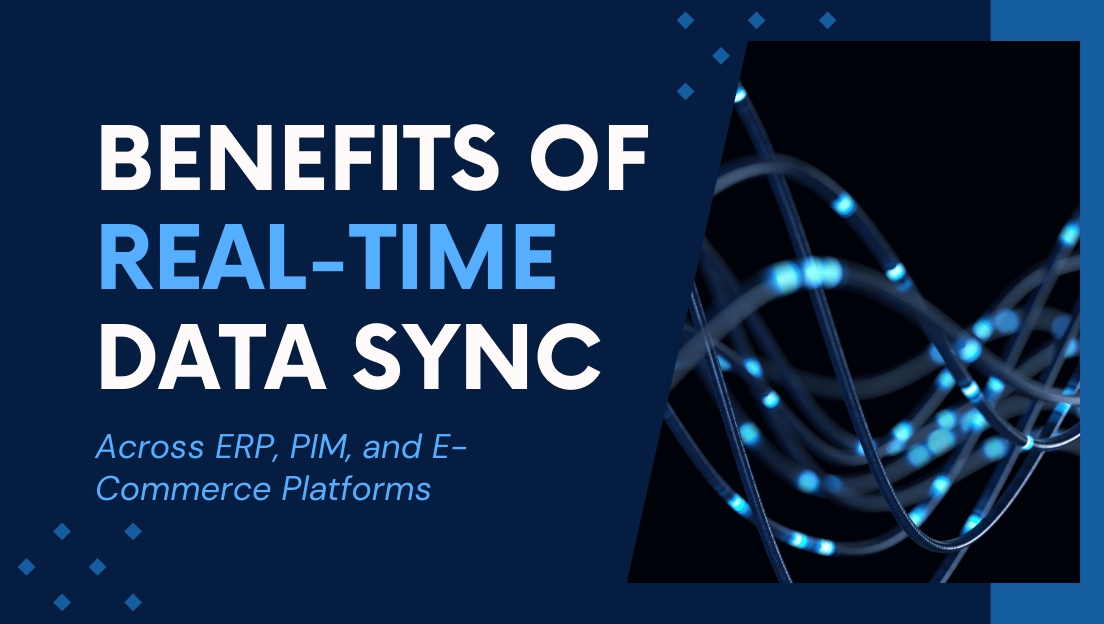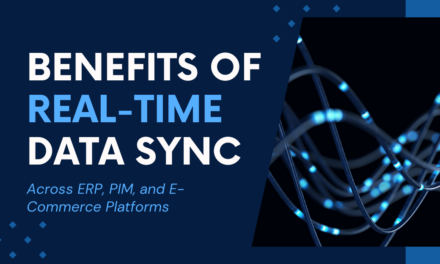
The Benefits of Real-Time Data Sync Across ERP, PIM, and E-Commerce Platforms

Introduction
For organizations striving to enhance operational efficiency and maximize sales, convincing leadership to invest in real-time data synchronization is a critical step. In today’s complex digital landscape, disparate systems such as Enterprise Resource Planning (ERP), Product Information Management (PIM), and e-commerce platforms must work seamlessly together to avoid costly inefficiencies and errors. Without real-time integration, companies face challenges like stock inaccuracies, fulfillment delays, and inconsistent product information—all of which negatively impact customer experience and revenue potential.
By implementing real-time data synchronization, businesses can eliminate redundant processes, reduce human error, and optimize operational workflows. This shift allows companies to focus on strategy and growth rather than being bogged down by manual updates and inefficiencies.
This article outlines the key advantages of real-time data synchronization, the leading tools available for implementation, and answers to common questions that can help you build a strong case for integration within your organization.
The Benefits of Real-Time Data Synchronization
1. Improved Inventory Management
Real-time synchronization ensures that stock levels are updated instantly across all sales channels, preventing overselling or stockouts. This leads to better inventory accuracy and reduces the risks associated with manual updates. With real-time visibility into inventory, businesses can optimize stock replenishment strategies, minimize holding costs, and improve supply chain coordination.
According to a study by IHL Group, retailers lose $1.75 trillion annually due to inventory distortion, which includes stockouts and overstocking.
2. Enhanced Order Processing and Fulfillment
Automated real-time data sync between ERP and e-commerce platforms helps streamline order processing, reducing delays and improving fulfillment times. Customers receive accurate shipping details, leading to a better shopping experience. By eliminating bottlenecks in order processing, businesses can reduce lead times, improve warehouse efficiency, and meet customer expectations for fast delivery.
McKinsey reports that companies with automated order processing experience a 25% faster order fulfillment time.
3. Consistent Product Information Across Channels
A PIM system ensures that product descriptions, pricing, and attributes remain consistent across all marketplaces and e-commerce sites. This improves brand credibility and reduces the risk of misleading customers. With accurate and enriched product data, businesses can optimize their product listings for search engines, enhance customer trust, and improve conversion rates.
According to a 2024 report by Dynamic Yield, the average cart abandonment rate worldwide was 73.9% in the 12 months ending July 2024.
4. Increased Sales and Revenue
With accurate inventory and pricing data available in real-time, businesses can take advantage of sales opportunities, optimize pricing strategies, and reduce lost sales. Real-time insights into sales trends enable data-driven decision-making, allowing businesses to dynamically adjust prices and promotions to maximize revenue.
Research from Harvard Business Review indicates that companies integrating real-time data synchronization can increase sales by up to 20%.
5. Operational Efficiency and Cost Savings
Manual data entry and reconciliation are time-consuming and prone to errors. Automating these processes with real-time synchronization reduces human error, lowers labor costs, and enhances operational efficiency. Integration also allows businesses to eliminate redundant workflows, improve collaboration between departments, and allocate resources more effectively.
Gartner estimates that automation reduces operational costs by 30% for businesses that implement real-time data sync solutions.
6. Better Customer Experience
Customers expect fast, reliable service and real-time order tracking. With integrated data systems, businesses can provide accurate delivery estimates, stock availability, and personalized recommendations. An optimized customer experience leads to increased customer loyalty, higher retention rates, and positive brand perception.
A PwC survey revealed that 73% of consumers consider customer experience a key factor in their purchasing decisions.
7. Improved Decision-Making with Data Insights
Real-time data allows businesses to analyze sales trends, track inventory performance, and optimize marketing strategies more effectively. Access to up-to-date analytics enables proactive decision-making, helping businesses stay competitive in a fast-changing market. Leaders can identify emerging trends, adjust product offerings, and make strategic investments based on real-time data.
McKinsey found that companies leveraging real-time data analytics see a 23% increase in business efficiency.
Tools for Real-Time Data Synchronization
Several tools enable seamless integration between ERP, PIM, and e-commerce platforms. Here are some of the top options:
1. SureDone (For enterprise sellers, brands, manufacturers, and Automotive, Motorsports, and powersports Sellers)
SureDone is a powerful e-commerce data automation engine and operations management platform. It consolidates data from ERP systems, PIM solutions, marketplaces, and websites, ensuring seamless real-time synchronization.
-
Key Features:
-
Consolidates product, inventory, pricing, and order data
- Integration with leading ERP and PIM systems, with rapid low cost connections to other systems via their unique Automation Engine.
-
Supports bulk management for large SKU counts
-
Provides an open API for extensive customization
-
Offers multichannel listing and inventory synchronization
-
Enhances marketplace performance with automation tools
- Acts as middleware between all of the e-commerce tools in your e-commerce stack
-
2. Rithum
Rithum (formerly known as CommerceHub) provides powerful e-commerce and supply chain integration solutions, allowing businesses to scale efficiently across multiple channels.
-
Key Features:
-
Integration with leading ERP and PIM systems
-
Advanced order and inventory management
-
Supports large-scale marketplace and retailer integrations
-
3. Salsify
Salsify specializes in product information management, ensuring accurate and enriched product data across multiple channels.
-
Key Features:
-
Centralized PIM for product data management
-
Digital asset management for images and videos
-
Syndication to various sales channels
-
4. Jitterbit
Jitterbit enables businesses to integrate and automate their data flow across ERP, CRM, and e-commerce platforms.
-
Key Features:
-
API-led integrations for scalability
-
User-friendly interface for building workflows
-
Conclusion
If your organization is looking to enhance efficiency, reduce costs, and boost revenue, real-time data synchronization should be a top priority. Presenting the benefits of integration to company leadership requires a focus on measurable impacts—such as increased sales, improved inventory accuracy, and enhanced customer experiences.
By adopting the right tools, such as SureDone, Rithum, or Salsify, businesses can eliminate operational bottlenecks and create a streamlined workflow that ensures data consistency across all systems. Investing in real-time data synchronization is not just a competitive advantage—it is a strategic necessity in today’s dynamic e-commerce environment. Now is the time to act and make real-time data synchronization a central part of your company’s future success.
Ready to master seasonal selling?
Get started with SureDone – the leading multichannel e-commerce platform for any business. Contact our sales team now or schedule your demo to unlock the full potential of your business with SureDone.









